#deitiesw
Text
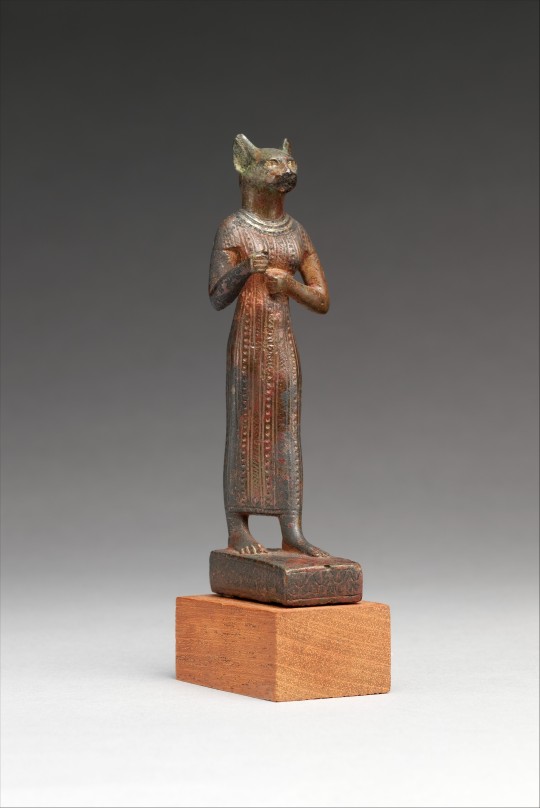
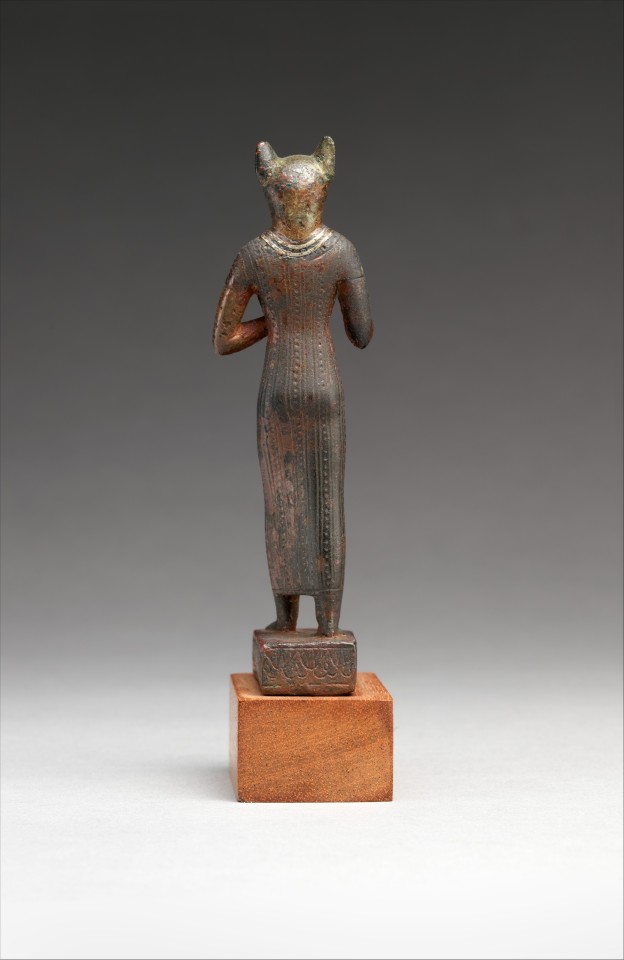
Bastet - Met Museum Collection
Inventory Number: 34.6.1
Late Period–Ptolemaic Period, 664–30 B.C.
Location Information: Location Unlisted
Description:
Bastet, here shown as a cat-headed goddess, was a powerful protective figure who also was known for her fertility. She could be represented with a lion head as well, but as a cat-headed goddess her peaceful traits were emphasized. Her personal adornments and garments are elaborate on statuettes, often more so than other goddesses, and she usually carries numerous attributes. This figure likely once held at least two separately-attached attributes, probably an aegis against her chest and a sistrum in her other hand. Her dress has an elaborate striped pattern with alternating dotted and lined bands. Bastet does not always wear a decorated dress, but it is much more common for her than for other goddesses. The patterning highlights its craftsmanship and quality; also, as some have suggested, the vertical banding may recall the striped fur of a cat.
Great attention to detail and color was lavished on this figure. Inlays are still visible in Bastet’s eyes, and alternating rows of precious metal and black bronze inlay form her broad collar. Also special to this piece is the base; rather than an inscription or blank register, as on most statuettes, this base bears a pattern of repeated lotus blossoms and buds.
#bastet#late period#ptolemaic#met museum#34.6.1#location unlisted#deities#deitiesw#womens clothing#LPWC#PWC
19 notes
·
View notes
Text






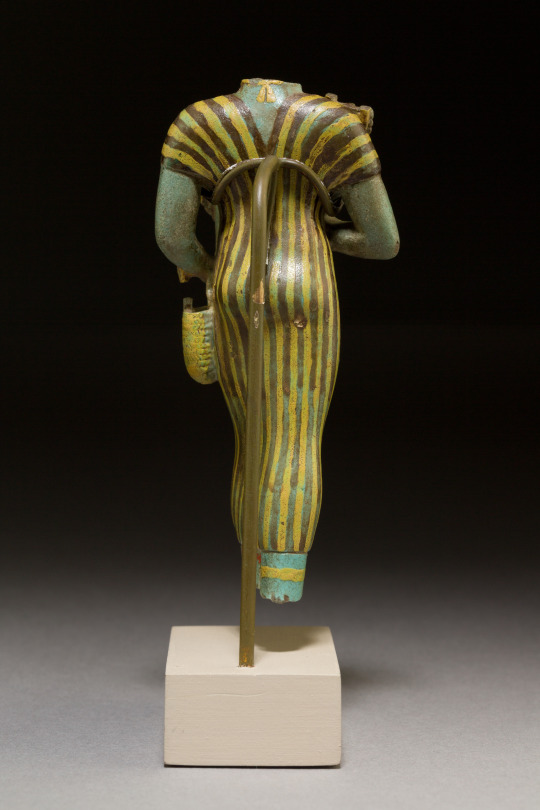
Bastet with Nefertum figure, sistrum, and basket - Met Museum Collection
Inventory Number: 17.194.2214
Third Intermediate Period–Late Period, 945–600 BC
Location Information: Location Unlisted
Description:
Although the head, made separately, is now missing, this goddess is identifiable as Bastet. The striped robe is characteristic of the goddess, as are the sistrum and basket she holds. The small statuette with a lotus crown represents her son Nefertum.
#Bastet with Nefertum figure sistrum and basket#bastet#third intermediate#late period#met museum#17.194.2214#location unlisted#womens clothing#TIWC#LPWC#deities#deitiesw
4 notes
·
View notes
Text

Queen Nefertari being led by Isis - Met Museum Collection
Note: This is a modern copy of an original
Inventory Number: 30.4.142
Original Dating: New Kingdom, Ramesside, Dynasty 19, ca. 1279–1213 B.C.
Location Information: Original from Egypt, Upper Egypt, Thebes, Valley of the Queens (Biban el-Malikat), Tomb of Nefertari (QV 66)
Description:
Nefertari was the main wife of pharaoh Ramesses II and her tomb with its vivid wall paintings is one of the most beautiful tombs in Egypt. This watercolor copy depicts the queen (left) being led by the goddess Isis (right). Noteworthy is that Nefertari’s husband, Ramesses II, is absent in these scenes, indicating the queen's high status that allowed her to directly interact with the deities without him; such depictions would not be possible for non-royal individuals.
#Queen Nefertari being led by Isis#new kingdom#ramesside#dynasty 19#upper egypt#thebes#valley of the queens#tomb of nefertari#met museum#30.4.142#deities#deitiesw#aset#womens clothing#NKRWC
0 notes
Text

Book of the Dead for the Chantress of Amun Nauny - Met Museum Collection
Inventory Number: 30.3.31
Third Intermediate Period, Dynasty 21, ca. 1050 B.C.
Location Information: From Egypt, Upper Egypt, Thebes, Deir el-Bahri, Tomb of Meritamun (TT 358, MMA 65), burial of Nauny, first corridor, inside Osiris figure, MMA excavations, 1928–29
Description:
This papyrus was part of the burial of Nauny, a Chantress of the god Amun-Re who died in her seventies. She also bore the title "king's daughter," which probably means that she was a child of the High Priest of Amun and titular king of the Theban area, Painedjem I.
On the papyrus are images and texts from a number of spells. The central scene illustrates Spell 125, better known as the Judgment of Osiris or The Weighing of the Heart. Nauny is in the Hall of Judgment. (...) Behind Nauny stands the goddess Isis, both wife and sister of Osiris. She is identified by the hieroglyph above her head.
#Book of the Dead for the Chantress of Amun Nauny#third intermediate#dynasty 21#upper egypt#thebes#deir el bahri#deir el-bahri#tomb of meritamun#met museum#30.3.31#womens clothing#TIWC#deities#deitiesw#aset
0 notes
Text


Funeral Boat, Tomb of Haremhab - Met Museum Collection
Note: This is a modern copy of an original
Inventory Number: 15.5.7
Original Dating: New Kingdom, Ramesside, Dynasty 19-20. ca. 1295–1070 BC
Location Information: From Egypt, Upper Egypt, Thebes, Khokha, Tomb of Haremhab (TT 207)
Description:
This facsimile painting copies a funeral scene from the Ramesside tomb of a scribe of the divine offerings of Amun named Haremhab. This detail depicts Isis and Nephthys, the divine sisters of the mortuary god Osiris, flanking an elaborate canopy draped with garlands that would have hidden and protected the deceased. A woman kneels in front of the canopy, her hand raised in a gesture of mourning. The scene takes place on the boat that would have carried the mummy to the necropolis.
#funeral boat#tomb of haremhab#new kingdom#ramesside#dynasty 19#dynasty 20#upper egypt#thebes#khokha#el-khokha#el khokha#womens hair and wigs#NKRWHW#deities#deitiesw#nebethet#aset#15.5.7#met museum
0 notes
Text

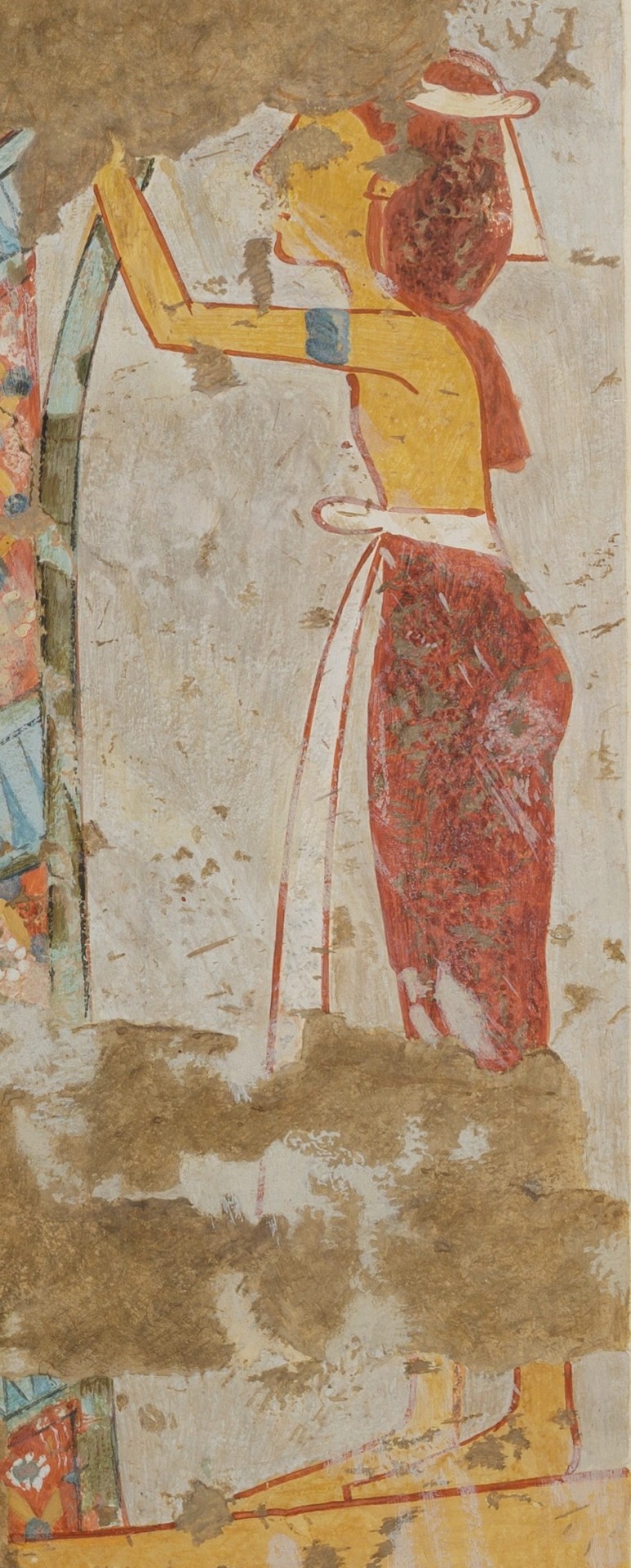
Funeral Boat, Tomb of Haremhab - Met Museum Collection
Note: This is a modern copy of an original
Inventory Number: 15.5.7
Original Dating: New Kingdom, Ramesside, Dynasty 19-20. ca. 1295–1070 BC
Location Information: From Egypt, Upper Egypt, Thebes, Khokha, Tomb of Haremhab (TT 207)
Description:
This facsimile painting copies a funeral scene from the Ramesside tomb of a scribe of the divine offerings of Amun named Haremhab. This detail depicts Isis and Nephthys, the divine sisters of the mortuary god Osiris, flanking an elaborate canopy draped with garlands that would have hidden and protected the deceased. A woman kneels in front of the canopy, her hand raised in a gesture of mourning. The scene takes place on the boat that would have carried the mummy to the necropolis.
#Funeral Boat#Tomb of Haremhab#new kingdom#ramesside#dynasty 19#dynasty 20#upper egypt#thebes#khokha#el khokha#el-khokha#deities#deitiesw#aset#nebethet#womens clothing#NKRWC#met museum#15.5.7
0 notes
Text
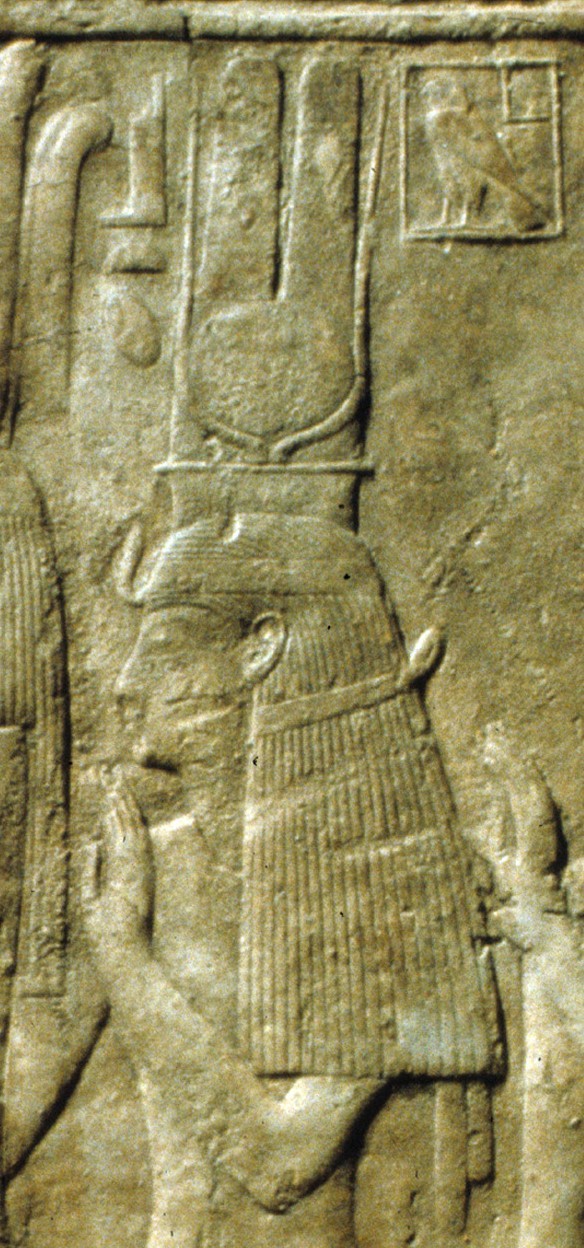

Relief from the South Wall of a Chapel of Ramesses I - Met Museum Collection
Inventory Number: 11.155.3c
Photo Focus: Aset (Isis) and Hathor
New Kingdom, Ramesside, Dynasty 19, ca. 1295–1294 B.C.
Location Information: From Egypt, Northern Upper Egypt, Abydos, Temple of Sety I, north of NE corner, Chapel of Ramesses I
Description:
Displayed in Gallery 129 are reliefs from three walls of the chapel of Ramesses I at Abydos. This monarch was a military officer from the eastern Delta. He served as a general and vizier under Haremhab, last king of Dynasty 18, and was designated by Haremhab as his successor. Ramesses was probably quite old when he became king and most of his monuments were finished by his son, Seti I.
The south wall of his temple at Abydos depicts Ramesses I and his family presenting offerings to Osiris. The upper register (now lost) showed Ramesses leading four young bulls to "Osiris Onnophris." In the lower register, Ramesses is shown "making incense and libation" over offerings piled before the shrine of "Osiris, lord of continuity, great god at home in Abydos." Behind the statue of Osiris stand the goddesses Isis and Hathor. Ramesses is accompanied by his queen, Sitre, who shakes two sistra. Behind her was a procession of men and women holding bouquets.
Ramesses I was the first king of Dynasty 19. He ascended the throne as an old man and was soon succeeded by his son, Seti I. Most of the monuments dedicated to Ramesses I, including this one, were built or completed by his son.
#Relief from the South Wall of a Chapel of Ramesses I#met museum#new kingdom#ramesside#dynasty 19#upper egypt#northern upper egypt#abydos#temple of sety I#Chapel of Ramesses I#11.155.3c#aset#hathor#deities#deitiesw#womens hair and wigs#hats#NKRWHW#NKRH
0 notes
Text

Ramesses III and Prince Amenherkhepeshef before Hathor - Met Museum Collection
Note: This is a Twentieth Century Copy
Photo Focus: Hathor
Inventory Number: 33.8.7
Original Dating: New Kingdom, Ramesside, Dynasty 20, ca. 1184–1153 B.C.
Location Information: Original from Egypt, Upper Egypt, Thebes, Valley of the Queens, Tomb of Amenherkhepeshef (QV 55), MMA graphic expedition 1933
Description:
This facsimile copies a scene in the tomb of Prince Amenherkhepeshef in the Valley of the Queens. It shows the prince following his father, Ramesses III, who is led by the goddess Hathor. Amenherkhepeshef wears a sidelock of hair, symbolic of youth. The king wears an elaborate garment with a feather pattern and long sashes.
#hathor#deities#Ramesses III and Prince Amenherkhepeshef before Hathor#met museum#new kingdom#ramesside#dynasty 20#upper egypt#thebes#valley of the queens#Tomb of Amenherkhepeshef#33.8.7#womens clothing#NKRWC#deitiesw
0 notes
Text


Ramesses III and Prince Amenherkhepeshef before Hathor - Met Museum Collection
Note: This is a Twentieth Century Copy
Photo Focus: Hathor
Inventory Number: 33.8.7
Original Dating: New Kingdom, Ramesside, Dynasty 20, ca. 1184–1153 B.C.
Location Information: Original from Egypt, Upper Egypt, Thebes, Valley of the Queens, Tomb of Amenherkhepeshef (QV 55), MMA graphic expedition 1933
Description:
This facsimile copies a scene in the tomb of Prince Amenherkhepeshef in the Valley of the Queens. It shows the prince following his father, Ramesses III, who is led by the goddess Hathor. Amenherkhepeshef wears a sidelock of hair, symbolic of youth. The king wears an elaborate garment with a feather pattern and long sashes.
#Ramesses III and Prince Amenherkhepeshef before Hathor#hathor#met museum#new kingdom#ramesside#dynasty 20#upper egypt#thebes#valley of the queens#Tomb of Amenherkhepeshef#33.8.7#womens hair and wigs#NKRWHW#deities#NKRH#hats#deitiesw
0 notes
Text

Papyrus - British Museum Collection
Photo Focus: Aset and Nebethet (deities)
Inventory Number: EA10470,2
New Kingdom Ramesside, Dynasty 19
Location Information: Tomb of Ani (Thebes) Africa: Egypt: Qena (Governorate): Luxor West Bank (Thebes): Tomb of Ani (Thebes)
Description:
Book of the Dead of Ani; frame 2; full colour vignettes; red borders. Vignette of sunrise; hymn to Osiris.
Inscription translation: Titles/epithets include : True Scribe of the King; His Beloved Scribe Reckoning Divine Offerings of All the Gods; Overseer of the Double Granary of the Lord of Tawer Titles/epithets include : Lady of the House; Chantress of Amun
#new kingdom#ramesside#dynasty 19#book of the dead of ani#aset#nebethet#deities#british museum#papyrus#EA10470.2#tomb of ani#luxor#luxor west bank#thebes#upper egypt#womens clothing#NKRWC#deitiesw
0 notes